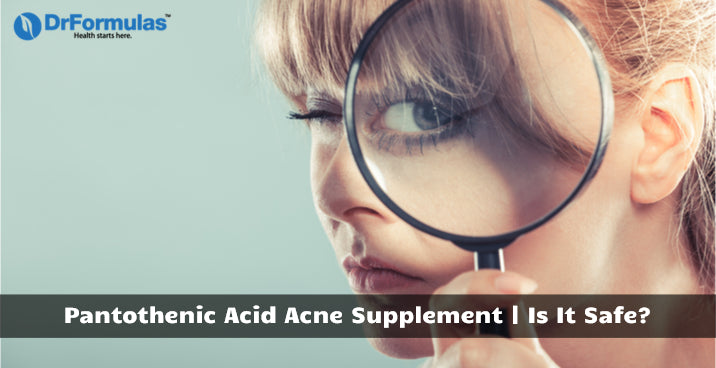
While there is still no current cure for acne, a variety of serums and supplements are designed to reduce breakouts and maintain a clear complexion. Pantothenic acid has become an increasingly popular treatment for acne. Learn more about pantothenic acid and whether or not it works for acne below.
What is Pantothenic Acid?
Also known as vitamin B5, pantothenic acid is an essential nutrient that can be obtained from a wide range of dietary sources. Pantothenic acid mainly plays a role in the synthesis of acyl carrier protein and coenzyme A (CoA). Both of these compounds are necessary for synthesizing fatty acids, though coenzyme A is also involved in the transfer of acetyl and acyl groups and various metabolic processes.1 Pantothenic acid also helps to maintain a healthy digestive tract, process other vitamins, and regulate cholesterol levels.2
Almost all plant- and animal-based foods contain some amount of pantothenic acid. Pantothenic acid is readily available in nearly all foods. The richest sources of this vitamin include:
- Beef
- Chicken
- Organ meats, particularly beef liver
- Whole grains
- Sunflower seeds
- Avocados
Pantothenic acid is also often added to some foods, including fortified breakfast cereals and beverages.1
The doses of pantothenic acid in food are less than the doses reported by users of pantothenic acid for acne.
High Dose Pantothenic Acid Side Effects
The study above and most other studies on pantothenic acid supplementation report no adverse side effects. Pantothenic acid is water-soluble, meaning it dissolves in water, and excess amounts of the vitamin will generally exit the body via sweat and urine.
Some studies report diarrhea and mild gastrointestinal distress from taking high doses of pantothenic acid.6 Furthermore, some anecdotal accounts and product reviews report:
- Headaches
- Kidney stones
- General kidney problems
Pantothenic Acid Acne Study
Studies have found that supplementing with pantothenic acid may reduce acne and promote clear skin. In one randomized, controlled, double-blind study, researchers evaluated the effects of 2,200 mg of pantothenic acid daily on 48 subjects diagnosed with mild to moderate forms of acne.
The subjects were either given 4 tablets daily of a dietary supplement containing 2,200 mg of pantothenic acid in total or a placebo for a period of 12 weeks. The primary metric was the difference in acne lesion counts between the two groups before and after the study period. Secondary metrics included average inflammatory and non-inflammatory lesion counts, as well as scores on the standardized Dermatology Life Quality Index (DLQI).
The results of the study found that the pantothenic acid group had a significantly reduced average lesion count compared to the placebo group. The pantothenic acid group also showed a significant reduction in inflammatory lesions, along with much lower DLQI scores. This suggests that using a pantothenic acid dietary supplement may effectively reduce acne lesions and inflammatory blemishes. Most importantly, pantothenic acid was found to be safe and well-tolerated by the participants.3
Proposed Mechanism of Action for Pantothenic Acid for Acne
How does pentothenic acid help acne? Although the exact mechanism of action is not well understood, researchers do know that pantothenic acid is a precursor to coenzyme A. The production of coenzyme A from pantothenic acid also requires 3 molecules of ATP for energy.
This energy consumption may play a role in lipid metabolism and fatty acid regulation as users of high doses of pantothenic acid have reported a “drying out” of the skin and decreased sebum production.
Sebum is an oily substance secreted from the sebaceous glands. Excess sebum contributes to clogged pores and inflammation, contributing to the formation of acne lesions. As pantothenic acid and coenzyme A play roles in the metabolism of lipids, researchers hypothesize that increasing the consumption of pantothenic acid may allow for more efficient breakdown of sebum, which is composed primarily of lipids.4
Other studies have also found that deficiencies in pantothenic acid may contribute to the pathogenesis of acne.5
Pantothenic acid may also regulate functions within the epidermal barrier by the proliferation and differentiation of keratinocytes.3
The exact associations between pantothenic acid and acne vulgaris, as well as the potential mechanisms at play, still require further study.
Using Pantothenic Acid for Acne
The recommended daily intake for pantothenic acid is up to 5 mg for both men and women. Women who are breastfeeding are recommended to take up to 7 mg of pantothenic acid.1
Users of pantothenic acid for acne report that in order for it to be effective, high doses above 2,000 mg per day are required. The study referenced above in which pantothenic acid was found to be effective for acne compared a dose of 2,200 mg pantothenic acid per day to placebo.
Along with using pantothenic acid, you can support a clear complexion by:
- Maintaining a regular skincare routine
- Incorporating effective spot treatments and serums
- Using natural moisturizers to control oil production
- Eating a healthy diet and exercising regularly
- Managing chronic stress in a constructive way
Pantothenic acid offers just one extra tool in your acne-fighting arsenal. Ingredients like purified and concentrated fish oil, turmeric, DIM, zinc, and probiotics can also help. These ingredients have been combined into one easy-to-take packet in DrFormulas® Clear Skin Support packets. For extra support, consult your dermatologist to determine other effective treatment options that can help to clear up your acne.
Sources:
- https://ods.od.nih.gov/factsheets/PantothenicAcid-HealthProfessional/
- https://www.livescience.com/51640-b5-pantothenic-acid.html
- https://link.springer.com/article/10.1007/s13555-014-0052-3
- http://orthomolecular.org/library/jom/1997/pdf/1997-v12n02-p099.pdf
- https://www.ncbi.nlm.nih.gov/pubmed/7476595
- Gropper SS, Smith JL, Groff JL (2009). Advanced nutrition and human metabolism. Belmont, CA: Wadsworth, Cengage Learning.


